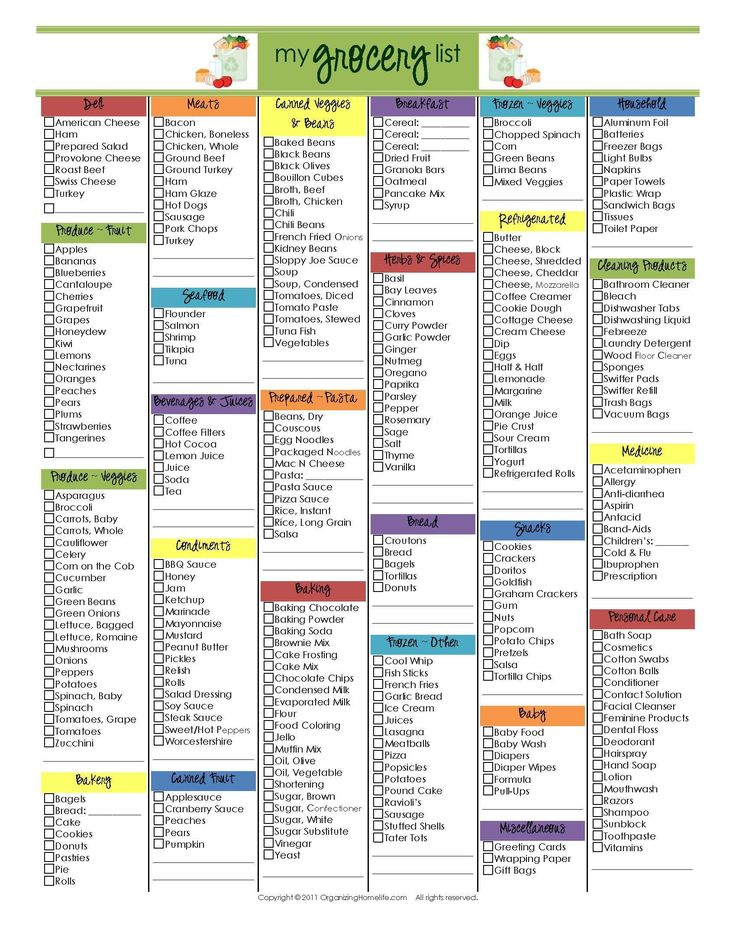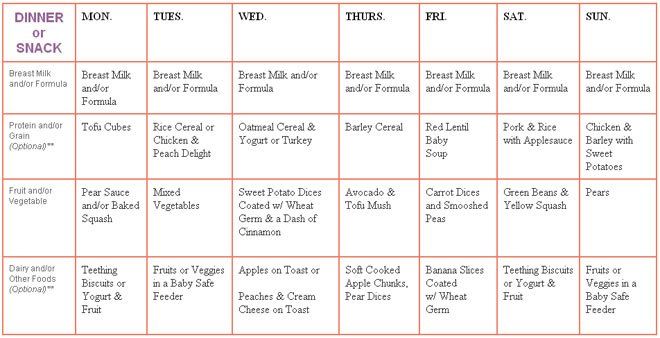Baby food serving sizes
How much should my baby eat? A guide to baby food portions
- Community
- Getting Pregnant
- Pregnancy
- Baby names
- Baby
- Toddler
- Child
- Health
- Family
- Courses
- Registry Builder
- Baby Products
Advertisement
Wondering how much to feed your baby? This can be hard to figure out, especially when you're starting solids and most of your baby's food ends up on your little one or the floor. It's also difficult to determine how much an 8-month-old (or older baby) should eat – babies this age are more interested in solid foods but still get most of their nutrition from breast milk or formula. This visual guide to baby food portions can help you figure out how much your baby should eat at every stage.
Photo credit: Karla Martin for BabyCenter
How much should my baby eat?
Do you worry that your baby is eating too little or too much? Your baby will self-regulate her food intake based on what their body needs, so let their appetite be your guide.
It's helpful to have a reference point, however. Here are photos of how much solid food a baby typically eats in a day. You can also ask your baby's doctor for feeding advice.
This visual guide shows:
- Portions for infants who are new to solids (typically 4 to 6 months)
- Two sample meals for a younger baby (6 to 8 months)
- Three sample meals and two snacks for an older baby (8 to 12 months) from a menu developed by the American Academy of Pediatrics (AAP)
Your little one may eat less or more than what's shown here. Your job is to provide a variety of healthy foods at regular intervals without pressure, and their job is to decide what and how much to eat.
Photo credit: iStock.com / UntitledImages
Watch for signs your baby is full
Lots of factors – including activity level, growth spurts or plateaus, illness, and teething – will affect your baby's appetite, which can vary daily.
End feeding when they signal that they're done. Signs of being full include:
Signs of being full include:
- Turning their head away
- Refusing to open their mouth for another bite after they've swallowed (resist the urge to encourage your baby to have one last spoonful)
- Leaning back in their chair
- Playing with the spoon or food rather than eating
Photo credit: Karla Martin for BabyCenter
How much a 4- to 6-month-old should eat
When your baby is developmentally ready for solids, typically around 4 to 6 months, talk to their doctor about introducing solid foods. The first bites are mostly about them getting used to the idea of having something different in their mouth.
- Start with a very small amount, 1 to 2 teaspoons, of a single-ingredient puree.
- Gradually increase to 1 to 2 tablespoons of food once a day.
- Follow your baby's fullness cues.
Popular first foods include pureed mango, banana, chicken, turkey, beef, peas, sweet potatoes, and infant cereal.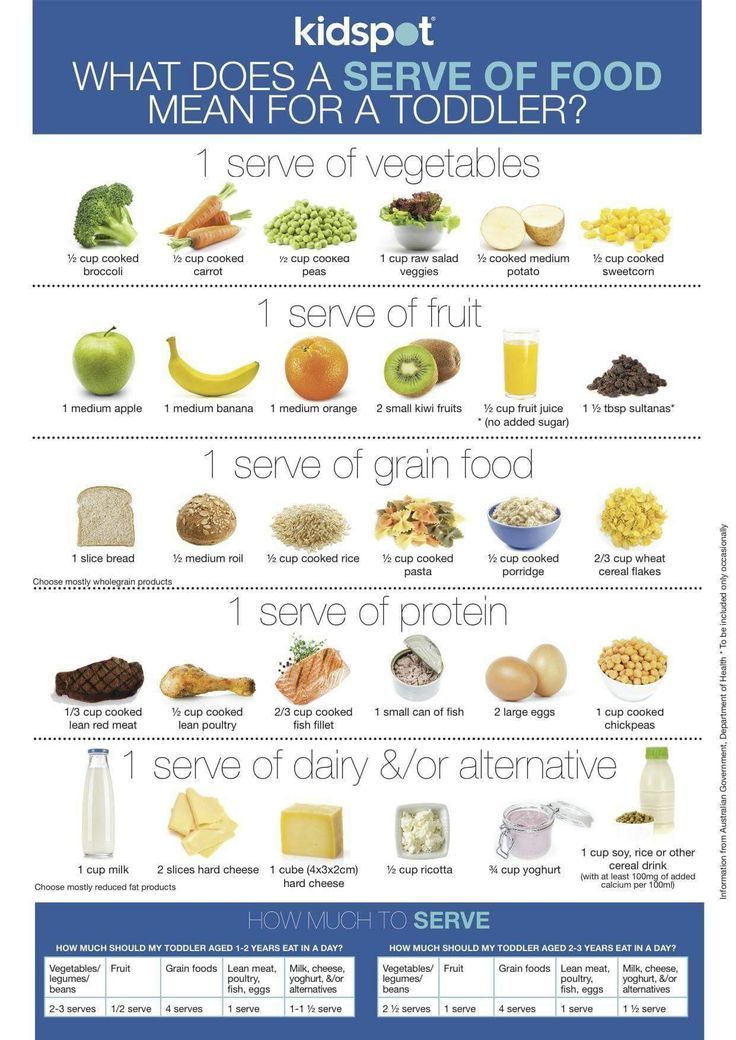 It's up to you what food to start with, but wait 3 to 5 days between introducing each new food to make sure your baby doesn't have an allergic reaction or food intolerance. (And remember, no cow's milk or honey until age 1.)
It's up to you what food to start with, but wait 3 to 5 days between introducing each new food to make sure your baby doesn't have an allergic reaction or food intolerance. (And remember, no cow's milk or honey until age 1.)
Photo credit: Karla Martin for BabyCenter
How much a 6- to 8-month-old should eat
As your little one gets more comfortable with solids, you can increase the frequency of meals and variety of food.
- Transition from one to two meals a day, typically by 8 months.
- Over time, add a second food to each meal. The photo above is an example of a meal with two foods.
- Once you've worked up to two meals with two foods each, aim for a balance of proteins, vegetables, fruits, and grains in their daily diet.
- Whenever you introduce a new food, start with a very small amount, a teaspoon or two, to allow your baby to get used to its flavor and texture.
- Start with a soupy consistency. Gradually add more texture as their eating skills improve.
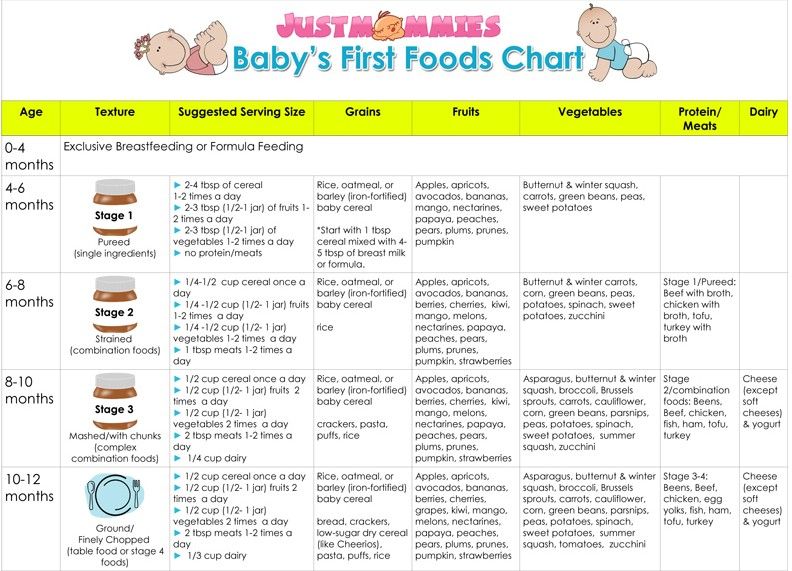
Expect their intake of breast milk or formula to go down. They'll start drinking less of it as they eat more solid foods. Provide healthy options at mealtimes, and let them choose how much to eat.
Note: The jars in all photos are standard 4-ounce baby food jars.
Photo credit: Karla Martin for BabyCenter
Breakfast for a younger baby (6 to 8 months)
Cereal and fruit make an easy combination for a morning meal.
Grain: Iron-fortified, whole-grain infant cereal is a popular first grain. At 6 months, a typical daily portion of infant cereal mixed with breast milk or formula might be 2 to 3 tablespoons, increasing to 4 to 8 tablespoons (1/4 to 1/2 cup) by 8 months. (It's best to avoid rice cereal, though.)
Fruit: Babies love the natural sweetness of fruits like pears, apples, berries, prunes, and stone fruits. Between 6 and 8 months, a baby will typically transition from about 2 to 3 tablespoons of fruit puree a day to 4 to 8 tablespoons (1/4 to 1/2 cup) of mashed or minced fruit.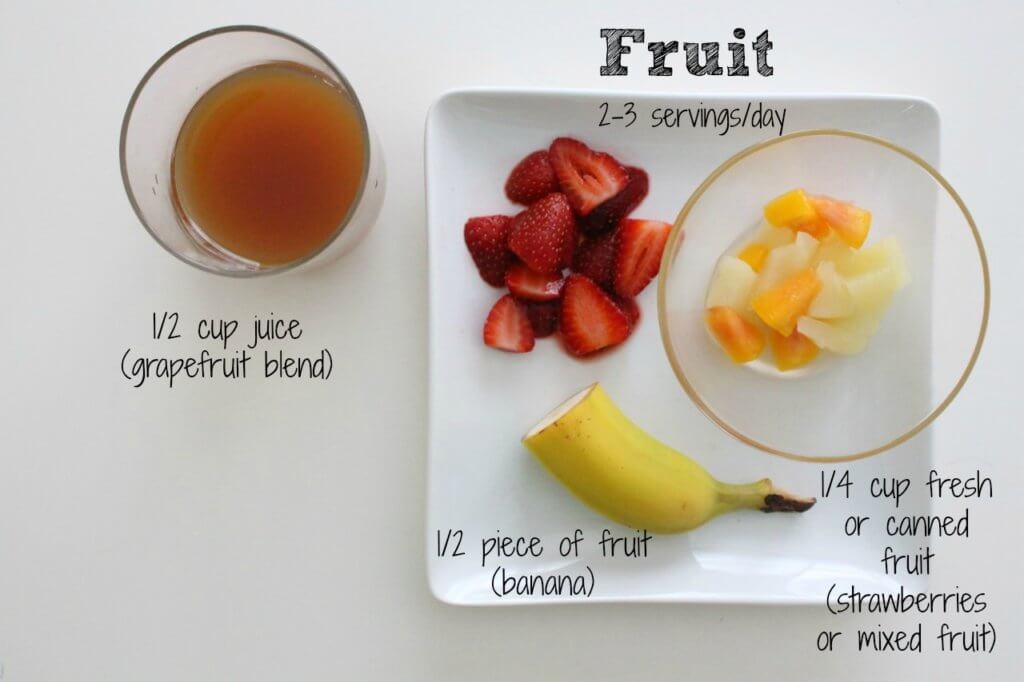
Photo credit: Karla Martin for BabyCenter
Dinner for a younger baby (6 to 8 months)
If you serve a grain and fruit in the morning, consider offering a protein-rich food and vegetable later in the day. Your child may eat more or less than the amounts shown.
Protein: A baby might transition from eating 1 to 2 tablespoons of meat puree at 6 months to 2 to 4 tablespoons at 8 months, for example. Other good protein sources include cheese, unsweetened plain whole-milk yogurt, tofu, beans, and lentils.
Vegetables: Between 6 and 8 months, a baby will typically transition from about 2 to 3 tablespoons of vegetable puree a day to 4 to 8 tablespoons (1/4 to 1/2 cup). Try classic favorites like carrots, spinach, or butternut squash, as well as less traditional first foods such as parsnips, beets, or asparagus.
As your child's eating skills improve, gradually add more texture by dicing or mincing foods.
Photo credit: Karla Martin for BabyCenter
How much an 8- to 12-month-old should eat
By 8 months or so, your baby is likely getting the hang of eating and needs to eat more calories to support their growing body. But since their little belly can't hold a lot of food, they'll need to eat more often. Every baby is different, but this may be a good time to try offering a third solid food meal.
But since their little belly can't hold a lot of food, they'll need to eat more often. Every baby is different, but this may be a good time to try offering a third solid food meal.
During this period:
- Continue to give your baby breast milk or formula.
- Add morning and afternoon snacks. (Some babies this age are happy with breast milk or formula as their snack, while others gravitate toward solid foods.) Once you've added a third meal and snacks, your baby will be eating or drinking something about every two to three hours.
- Continue to aim for a mix of proteins, vegetables, fruits, and grains.
- Introduce coarser and chunkier textures, for example, by dicing or mincing food instead of pureeing it, and graduate to soft finger foods as your baby's eating skills improve.
- Avoid foods with added sugars. Check the Nutrition Facts label on packaged foods, and try to steer clear of foods that list 1 gram or more of "Added Sugars.
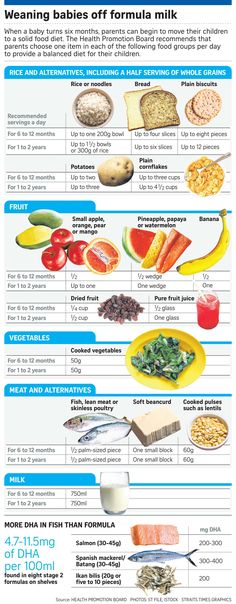 "
" - Provide healthy options, and let your baby choose how much to eat.
To visualize daily portions for an 8- to 12-month-old, check out the following photos of a typical day's menu for a baby this age, developed by the AAP.
Your child may eat more or less than these amounts. If you're concerned about how much your baby is eating, talk to their doctor for advice.
Photo credit: Karla Martin for BabyCenter
Breakfast for an older baby (8 to 12 months)
The AAP sample menu for a baby 8 to 12 months features a breakfast consisting of:
- 4 to 8 tablespoons (1/4 to 1/2 cup) whole-grain infant cereal mixed with formula or breast milk
- 4 to 8 tablespoons (1/4 to 1/2 cup) diced fruit
Note: This is an example. Your baby may eat different foods and amounts.
Photo credit: Karla Martin for BabyCenter
Morning snack for an older baby (8 to 12 months)
The AAP sample menu for a baby 8 to 12 months features a morning snack consisting of:
- 4 tablespoons (1/4 cup) diced cheese or cooked vegetables
Note: This is an example of a morning snack, which babies typically add sometime between 8 and 12 months.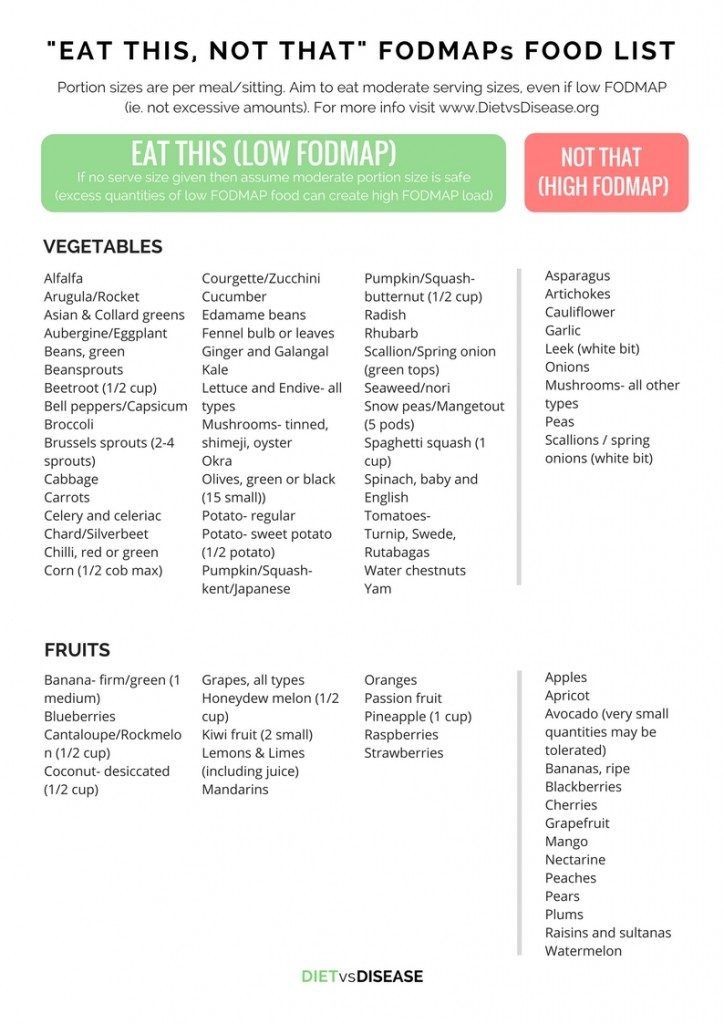 Your baby may eat different foods and amounts.
Your baby may eat different foods and amounts.
Photo credit: Karla Martin for BabyCenter
Lunch for an older baby (8 to 12 months)
The AAP sample menu for a baby 8 to 12 months features a lunch consisting of:
- 4 to 8 tablespoons (1/4 to 1/2 cup) unsweetened plain whole-milk yogurt or cottage cheese, or minced meat
- 4 to 8 tablespoons (1/4 to 1/2 cup) diced or mashed yellow or orange vegetable
Note: This is an example. Your baby may eat different foods and amounts.
Photo credit: Karla Martin for BabyCenter
Afternoon snack for an older baby (8 to 12 months)
The AAP sample menu for a baby 8 to 12 months features an afternoon snack consisting of:
- 4 tablespoons (1/4 cup) diced fruit or unsweetened plain whole-milk yogurt
- 1 whole-grain teething biscuit or cracker
Note: This is an example of an afternoon snack, which babies typically add sometime between 8 and 12 months.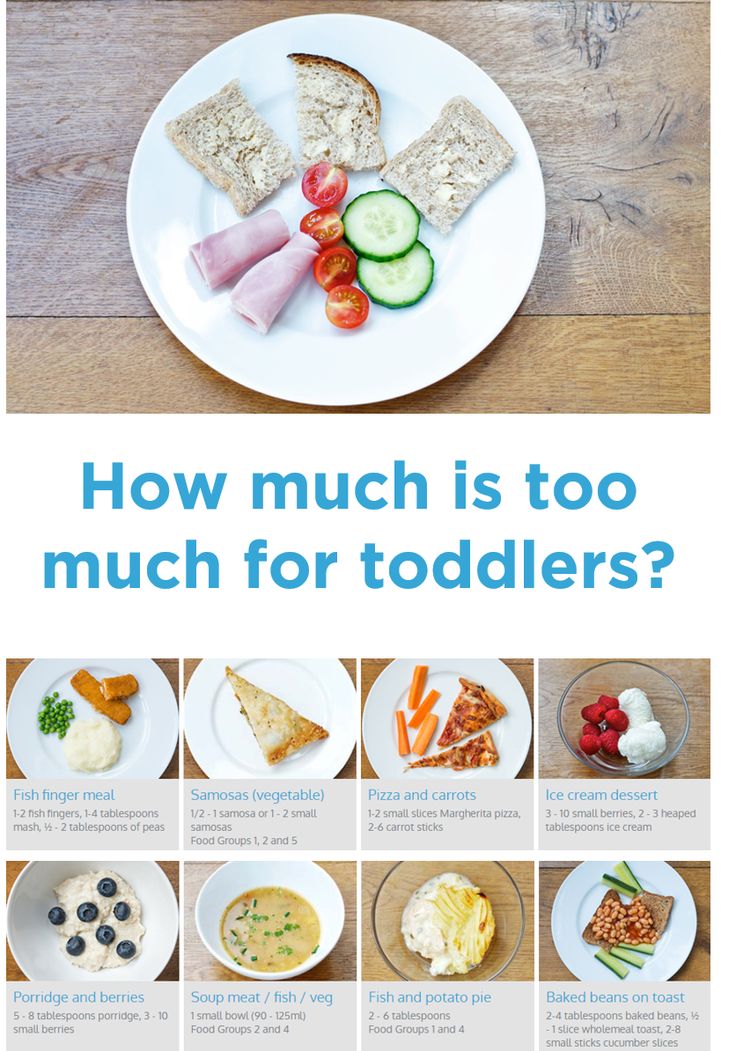 Your baby may eat different foods and amounts.
Your baby may eat different foods and amounts.
Photo credit: Karla Martin for BabyCenter
Dinner for older baby (8 to 12 months)
The AAP sample menu for a baby 8 to 12 months features a dinner consisting of:
- 4 tablespoons (1/4 cup) minced or ground poultry or meat, or diced tofu
- 4 to 8 tablespoons (1/4 to 1/2) cup diced, cooked green vegetable
- 4 tablespoons (1/4 cup) noodles, pasta, rice, or potato
- 4 tablespoons (1/4 cup) diced fruit
Note: This is an example. Your baby may eat different foods and amounts.
Photo credit: Karla Martin for BabyCenter
How much should my baby drink once they start eating solids?
Breast milk or formula will fully meet your child's hydration needs until they're about 6 months old. They may start drinking less as solid foods become a bigger part of their diet. Here are typical daily amounts by age – your baby's intake may be different, however.
6 to 8 months: 24 to 32 ounces of formula, or continued breastfeeding on demand
8 to 12 months: 24 ounces of formula, or continued breastfeeding on demand
Water: You can offer your baby water once they start eating solids, but let them self-regulate how much they drink. The Centers for Disease Control and Prevention (CDC) recommends giving babies who are 6 to 12 months old 4 to 6 ounces of water a day, but what your baby decides to drink may vary. They may drink more on a hot day, for example.
Avoid juice: Juice isn't recommended for babies younger than 12 months.
Photo credit: iStock.com / SDI Productions
Your baby has the final say
Keep in mind that these portions are an estimate. The truth is, every baby is different, and there's no set amount of food that's appropriate for every baby at every stage.
If you're worried about whether your baby is eating enough – or too much – the best advice is to look for and respond to signs that your baby is full.
Your baby's doctor will chart their weight gain at regular intervals. If the doctor sees a consistent growth curve and doesn't have other concerns, your baby is most likely eating the right amount of food.
Hungry for more?
Age-by-age guide to feeding your baby
The 10 best foods for babies
The worst foods for babies
Using spices and seasoning in baby food
Elizabeth Dougherty
Elizabeth Dougherty is a veteran parenting writer and editor who's been contributing to BabyCenter since 2015. She's an intrepid traveler, devoted yogi, and longtime resident of Silicon Valley, where she lives with her husband and son.
Advertisement | page continues below
Serving Sizes for Toddlers - HealthyChildren.org
Log in | Register
Ages & Stages
Ages & Stages
A toddler's daily energy requirements are not very large.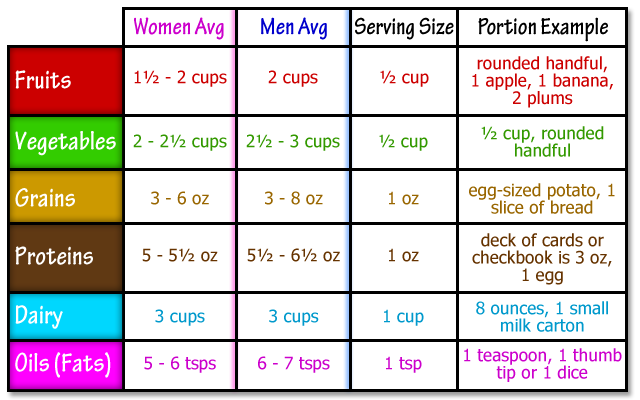 After tripling their birth weight by their first babies, a child's growth slows down. So, the amount they eat does not need to be huge.
After tripling their birth weight by their first babies, a child's growth slows down. So, the amount they eat does not need to be huge.
A general guide for feeding your toddler
Each day, a child between ages 1 and 3 years needs about 40 calories for every inch of height. This means that a toddler who measures 32 inches in height, for example, should be taking in an average of about 1,300 calories a day. However, the amount varies with each child's build and activity level.
The child's serving size should be approximately one-quarter of an adult's.
Example of an average toddler-sized meal
One ounce of meat, or 2 to 3 tablespoons of beans
One to 2 tablespoons of vegetables
One to 2 tablespoons of fruit
One-quarter slice of bread
Your toddler will get enough calories along with all the protein, vitamins, and minerals they need from an average daily intake similar to the chart below.
Food Group | Servings Per Day | Number of Calories Per Day | One Serving Equals |
Grains | 6 | 250 |
|
Vegetables | 2 to 3 | 75 |
|
Fruits | 2 to 3 | 75 |
|
Dairy | 2 to 3 | 300-450 | |
Protein (meat, fish, poultry, tofu) | 2 | 200 | |
Legumes | 2 | 200 | |
Peanut butter (smooth only) | 95 |
More information
- Sample Menu for a Two-Year-Old
- Selecting Snacks for Toddlers
- How to Get Your Child to Eat More Fruits and Veggies
- Ask the Pediatrician: How do I help my picky eater try more healthy foods?
- Last Updated
- 8/15/2022
- Source
- Committee on Nutrition (Copyright © 2016 American Academy of Pediatrics)
The information contained on this Web site should not be used as a substitute for the medical care and advice of your pediatrician. There may be variations in treatment that your pediatrician may recommend based on individual facts and circumstances.
There may be variations in treatment that your pediatrician may recommend based on individual facts and circumstances.
Union of Pediatricians of Russia
Nutrition for children from 1 to 3 years of age
The period from 1 to 3 years of life is a crucial stage in the transition to an adult type of nutrition, which has certain features. In order to ensure that all the necessary nutrients enter the child's body and at the same time prevent an excess of individual nutrients, nutrition should be balanced and varied. nine0003
The daily amount of food for children aged 1 to 1.5 years should be 1000-1200 g, from 1.5 to 3 years - 1200-1500 g, the amount of food in one feeding should not exceed 300-350 ml. The diet consists of three main meals per day and two snacks. It is considered optimal when breakfast is 25% of the total energy density of the diet, lunch is 30–35%, dinner is 20%, and additional meals are about 10%. In general, the child can eat the same food as the rest of the family. nine0003
nine0003
In the diet of a child of 1–3 years of age , must be present daily: meat of animals or poultry, dairy and sour-milk products, vegetables, fruits, bread, cereals, vegetable and butter; fish and eggs are included in the diet 2-3 times a week.
Cereal products: bread - 2-3 servings per day, cereals and side dishes - 1 time per day
Fruit and/or vegetables: at least 5 times a day
Dairy products: at least 3 servings per day (including those used to make cereals, yoghurts, fermented milk drinks, cottage cheese, infant formula or breast milk). nine0003
Domestic pediatricians recommend, when compiling a diet for children aged 1–3 years, preference should be given to specialized children's dairy products of industrial production that meet high quality requirements and safety indicators for this age. Most children's dairy products are additionally enriched with vitamins and/or minerals and other biologically active components, taking into account the physiological needs of children of this age. At the same time, in foreign recommendations, children over 1 year old are offered the gradual introduction of whole cow's milk, which is rich in fats necessary for proper growth and development, the absorption of vitamins A and D, the development of the child's brain and nervous system. nine0003
At the same time, in foreign recommendations, children over 1 year old are offered the gradual introduction of whole cow's milk, which is rich in fats necessary for proper growth and development, the absorption of vitamins A and D, the development of the child's brain and nervous system. nine0003
Meat dishes: 2-3 times a day
Fish dishes: 2-3 servings per week
Eggs: 2-3 per week
Dietary fats: 3-4 teaspoons of butter and/or vegetable oils per day
When cooking, use the minimum amount of salt and sugar, and do not add them to industrial products.
Offer your child a variety of foods and let them choose for themselves. Children love to eat on their own, so if possible, offer food that the child can eat with their hands. nine0003
It is important to remember that a baby can choke on pieces of food, so whatever you give your baby should be crushed or cut into small pieces that can be easily chewed.
Do not give to a small child: nuts, whole grapes, cherry tomatoes (unless quartered), whole carrots, seeds (such as pumpkin or sunflower seeds), round candies, legumes, raisins, because a child can eat them choke.
Also in the diet of children of the first 3 years of life should not be present:
Mushrooms; canned snacks, pickled vegetables and fruits
Home canned food
Dry concentrates for side dishes
Hot sauces, mustard, horseradish, pepper, vinegar, mayonnaise
Natural coffee
Juices and drinks in the form of dry concentrates; sweet carbonated drinks
Products containing food additives (flavorings, dyes of artificial origin, including chewing gum), popcorn
Combined fats; cakes and pastries
It is important to remember that children of this age should not be given too spicy and spicy foods.
How to calculate the portion size for proper nutrition?
How often do you read food label recommendations for portion sizes? If your answer is “never” or “rarely”, you are not alone.
Most of us do not think about such trifles, but meanwhile, simple comparisons show that the "standard servings" of some familiar foods are getting larger every year. Simple example: at 19In the 90s, a regular bun weighed 40 g, now it is 55.
Simple example: at 19In the 90s, a regular bun weighed 40 g, now it is 55.
The experts began to calculate portion sizes with proper nutrition, so that you can eat different foods and not gain weight.
Actual servings versus recommended
We buy many products in packages and naively believe that one jar of yogurt or smoothie, one bag of juice or nuts is one serving. In fact, everything is far from being so simple. For example, the recommended serving of yogurt is 150–200 g, while on the shelves you will find many packages of 250 or 300 g. Not to mention the large “family” packages, which are usually cheaper per kilogram of product, but in this case, not everyone is able to correctly assess the volume of a serving. nine0003
Which? - A British organization, which, like Roskachestvo, is a member of the International Assembly of Consumer Testing Organizations, recently conducted an experiment to calculate how many cereals the British eat for breakfast. The experts compared the servings recommended by the manufacturers on the packaging and the actual servings that the participants in the experiment ate for breakfast. It turned out that real portions exceeded the recommended by an average of 63%.
The experts compared the servings recommended by the manufacturers on the packaging and the actual servings that the participants in the experiment ate for breakfast. It turned out that real portions exceeded the recommended by an average of 63%.
If you carefully study the labels of products, you can find other interesting details. For example, a small chocolate bar weighing 45 g is considered one serving. But if you buy a large, 200-gram bar of the same brand, then the package will say that there are eight servings in it, that is, one serving will be only 25 g. nine0003
Another example: Coca-Cola comes in 150, 250, and 330 ml packs, all of which count as one serving. But the difference in volume is very significant!
We eat more than we need
These inconsistencies forced the Which? go beyond cereal and conduct a massive study in June 2020 involving 1239human.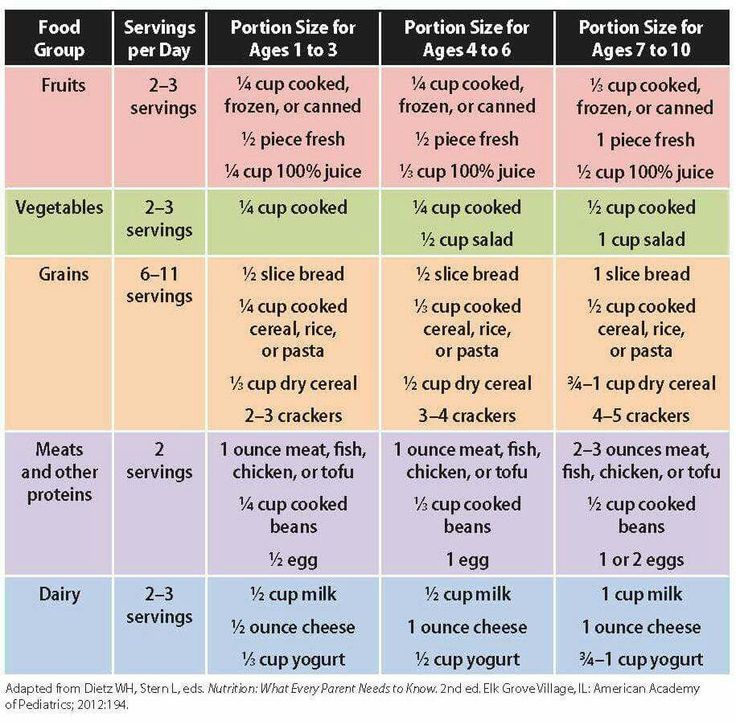 All volunteers were asked what they thought was the recommended serving size for several popular foods.
All volunteers were asked what they thought was the recommended serving size for several popular foods.
The results showed that we very often overestimate the portion size and because of this we eat more than we need, and therefore gain weight. For example, the recommended serving size of chips in a tube is 30 g (as indicated on the package) - this is about 14 pieces, but 28% of respondents said that they eat more than a quarter of the package (50 g), and some admitted that they were able to kill in one sitting whole jar. Explanation: if you leave the chips in an open jar, “they don’t taste as good”, so it’s better to eat them right away and get the most out of it. nine0003
A standard frozen pizza sold in supermarkets weighs 300-350 grams, and many consider this volume to be one serving, but in fact such a pizza is intended for two. In addition, the majority of participants believed that the recommended portion of cookies is 4-5 pieces (actually 2), and a bag of popular Smarties sweets is designed for one (actually - for two).
How to calculate KBJU so as not to gain weight remotely - HERE .
How to calculate the amount of products for an average serving?
Anna Ivashkevich
nutritionist, clinical nutritionist, member of the National Association of Clinical Nutrition
“Indeed, portion sizes are getting bigger these days, and people are overeating. The most difficult thing is to stop in time when you eat salty, sweet, starchy foods or foods with flavor enhancers - primarily convenience foods and fast food. How to calculate the correct serving size? It all depends on your goal. Do you want to lose weight, keep it off, or, conversely, gain it? In cases where you need to reduce or increase weight, it is wiser to start with the advice of a professional nutritionist who will help you adjust your diet. If you want to maintain weight, then follow these rules: nine0003
-
If we talk about energy value, then the distribution of calories per meal should be as follows: each meal 40% of calories should come from carbohydrates, 30% from proteins and 30% from fats.

-
The optimal composition of the main meal is 150 g of proteins + 200 g of carbohydrates + fats. What fats do I recommend? You can choose one of the following list: 1 tbsp. l. olive oil, 1 g butter, ½ avocado or 50 g cheese. nine0003
Portions for men can be slightly larger than for women, and here it is worth focusing on counting kilocalories. A woman with average physical activity needs 1800-2000 calories per day, a man - 2000-2200.
Your optimal portion, in grams:
-
Meat - 150-200
-
Bird - 150–200
nine0105 -
Fish and seafood - 200–300
-
Dry pasta - 60-100
-
Dry cereals - 60-100
-
Pizza - 2-3 pieces of 150
-
Dumplings - 250–300
-
Soups - 300 nine0003
-
Potatoes - 200–300
-
Curd - 100–200
-
Yoghurts - 150-200 (1 cup)
-
Vegetables - 300
-
Fruit - 150-300
-
Nuts - 20-30
nine0105 -
Sweet (it is better not to eat it at all, but in an ideal world) - 1 cake / piece of cake / bun 80
How do you rate portions in a restaurant?
Portions in restaurants, cafes and other establishments are usually larger than what we cook at home. For example, a standard serving of cola in fast food restaurants is typically 400 ml, and the largest is 1123 ml, which is much larger than the standard serving size of 250 ml. A chocolate muffin from a coffee shop weighs about 110 g, and from a supermarket - 75 g. The volume of a standard coffee is 300-350 ml, and a large cup can be up to 500 ml. And if the drink is prepared with milk and syrup, then its energy value can reach 350 kcal - a real dessert! Portions of salad, soup or pasta in many restaurants exceed the amount that we would eat at home. All this contributes to an increase in home portions, as those who often eat in cafes and restaurants get used to large volumes. nine0003
For example, a standard serving of cola in fast food restaurants is typically 400 ml, and the largest is 1123 ml, which is much larger than the standard serving size of 250 ml. A chocolate muffin from a coffee shop weighs about 110 g, and from a supermarket - 75 g. The volume of a standard coffee is 300-350 ml, and a large cup can be up to 500 ml. And if the drink is prepared with milk and syrup, then its energy value can reach 350 kcal - a real dessert! Portions of salad, soup or pasta in many restaurants exceed the amount that we would eat at home. All this contributes to an increase in home portions, as those who often eat in cafes and restaurants get used to large volumes. nine0003
- In a restaurant, always evaluate dishes by the amount of fat - by adding oil and sauces, calorie content can increase significantly, - Anna Ivashkevich explains . - Look at the menu for the gram of the dish, and if you carefully follow the figure, you can ask for a map of dishes by calorie content and composition.





